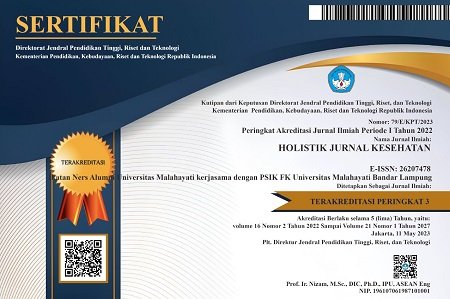Self efficacy dalam penggunaan kondom pada Lelaki Seks Lelaki (LSL) dengan HIV/AIDS: Literature review
Abstract
Background: The prevalence of HIV / AIDS in the world is increasing. Men who have sex with men (MSM) is the population most vulnerable to HIV / AIDS. Transmission occurred because of the low use of condoms. Self-efficacy is the ability to belief of self against individual coping in specific situations that affect thinking, behavior, and emotional patterns that can affect attitudes in controlling motivation, behavior, social and the surrounding environment
Purpose: A literature study was explore self-efficacy in using condom and measurement of self-efficacy in condom use
Method: Literature studies used the online database Proquest, CINAHL, the literature was limited by criteria: in 2016-2019, full text and English language, with the keywords: "Self-Efficacy AND Condom Use", "HIV / AIDS AND MSM," HIV / AIDS AND Self Efficacy
Results: Finding 9 articles that were relevant to the inclusion criteria. The results showed that there were two categories in the assessment of self-efficacy in HIV / AIDS patients, namely Sexual Self-Efficacy, and Condom Self-Efficacy
Conclusion: The assessment used several different instruments, however, although the instruments used were different in the assessment of self-efficacy, the results of the entire study showed a link between self-efficacy in the use of condoms in MSM. The results of this literature review can be used as information material about the importance of self efficacy in improving the consistency of condom use to prevent HIV / AIDS
Keywords: HIV/AIDS; Self-Efficacy, Condom Use; Sexual risk; Behavior
Pendahuluan: Prevalensi HIV/AIDS di dunia semakin meningkat. Lelaki seks lelaki (LSL ) merupakan populasi yang paling mudah terkena HIV/AIDS. Penularan terjadi karena rendahnya penggunaan kondom. Self-efficacy merupakan kemampuan untuk percaya pada kemampuan diri terhadap koping individu dalam situasi yang spesifik yang mempengaruhi pemikiran, perilaku, dan pola emosional yang dapat berdampak pada sikap dalam mengontrol motivasi, perilaku, dan sosial serta lingkungan sekitar.
Tujuan: Untuk mengeksplorasi self-efficacy dalam penggunaan kondom dan pengukuran self-efficacy dalam penggunaan kondom.
Metode: Studi literatur melalui database online Proquest, CINAHL, literature dibatasi dengan kriteria : tahun 2016-2019, full text dan berbahasa Inggris, dengan kata kunci: “Self-Efficacy AND Condom Use”,“HIV/AIDS AND MSM,”HIV/AIDS AND Self Efficacy
Hasil: Didapatkan self-efficacy pada pasien HIV/AIDS dibedakan menjadi Sexual Self- Efficacy, dan Condom Self-Efficacy dan penilaian menggunakan beberapa instrument yakni sexual self-efficacy scale, the AIDS-Prevention Self-efficacy Scal, condom use self-efficacy, condom use self-efficacy scale,
Simpulan: terdapat instrumen yang berbeda namun, meskipun instrumen yang digunakan berbeda dalam penilaian self-efficacy namun seluruh hasil penelitan menunjukkan adanya keterkaitan self-efficacy dalam penggunaan kondom pada LSL. Hasil telaah literature ini dapat dijadikan bahan informasi tentang pentingnya self efficacy dalam meningkatkan konsistensi penggunaan kondom untuk mencegah HIV/AIDS.
Keywords
References
Ajayi, A. I., Ismail, K. O., & Akpan, W. (2019). Factors associated with consistent condom use: a cross-sectional survey of two Nigerian universities. BMC public health, 19(1), 1207.
Ajayi, A. I., Olawale, E., & Id, O. (2019). What predicts self-efficacy ? Understanding the role of sociodemographic , behavioural and parental factors on condom use self- efficacy among university students in Nigeria, 1–20. https://doi.org/10.1371/journal.pone.0221804
Asante, K. O. (2016). The Role of Condom Use Self-Efficacy on Intended and Actual Condom Use Among University Students in Ghana. Journal of Community Health, 41(1), 97–104. https://doi.org/10.1007/s10900-015-0073-6
Asante, K. O., Osafo, J., & Doku, P. N. (2016). The role of condom use self-efficacy on intended and actual condom use among university students in Ghana. Journal of community health, 41(1), 97-104.
Belil, E. F., Alhani, F., Ebadi, A., & Kazemnejad, A. (2018). Self-efficacy of people with chronic conditions: A qualitative directed content analysis. Journal of clinical medicine, 7(11), 411. https://doi.org/10.3390/jcm7110411
Centers for Disease Control and Prevention. (2018). HIV and Gay and Bisexual Men. Retrieved from https://www.cdc.gov/hiv/group/msm/index.html
Closson, K., Dietrich, J. J., Lachowsky, N. J., Nkala, B., Palmer, A., Cui, Z., & Kaida, A. (2018). Gender, sexual self-efficacy and consistent condom use among adolescents living in the HIV hyper-endemic setting of Soweto, South Africa. AIDS and Behavior, 22(2), 671-680.
Closson, K., Janine, J., Nathan, D., Nkala, B., Palmer, A., Cui, Z., …
Kaida, A. (2017). Gender , Sexual Self ‑Efficacy and Consistent Condom Use Among Adolescents Living in the HIV Hyper ‑ Endemic
Dawson, E. L., Mendoza, M. C., Gaul, Z., Jeffries Iv, W. L., Sutton, M. Y., & Wilson, P. A. (2019). Resilience, condom use self-efficacy, internalized homophobia, and condomless anal sex among black men who have sex with men, New York City. PloS one, 14(4), e0215455.
Fauziyah, F., Shaluhiyah, Z., & Prabamurti, P. N. (2018). Respon Remaja Lelaki Suka Lelaki (LSL) dengan Status HIV Positif terhadap Pencegahan Penularan HIV kepada Pasangan. Jurnal Promosi Kesehatan Indonesia, 13(1), 17-31.
Kana, I. M., Nayoan, C. R., & Limbu, R. (2016). Gambaran perilaku pencegahan hiv dan aids pada lelaki suka lelaki (lsl) di kota kupang tahun 2014. Unnes Journal of Public Health, 5(3), 252-262.
Khumsaen, N., & Stephenson, R. (2017). Beliefs and perception about HIV/AIDS, self-efficacy, and HIV sexual risk behaviors among young Thai men who have sex with men. AIDS Education and
Li, H., Xue, L., Tucker, J. D., Wei, C., Durvasula, M., Hu, W., & Kang, D. (2017). Condom use peer norms and self-efficacy as mediators between community engagement and condom use among Chinese men who have sex with men, 1–9. https://doi.org/10.1186/s12889-017-4662-4
Louw, J., Peltzer, K., & Chirinda, W. (2012). Correlates of HIV risk reduction self-efficacy among youth in South Africa. The Scientific World Journal, 2012.
Luévano-flores, P. A., & Rubia, J. M. (2017b). An exploratory qualitative study on the social representation of HIV / AIDS in young men who have sex with men. Medicina Universitaria, 19(77), 170–177. https://doi.org/10.1016/j.rmu.2017.10.006
Manjengwa, P. G., Mangold, K., Musekiwa, A., Kuonza, L. R., Field, S. A., & Training, E. (2019). Cognitive and behavioural determinants of multiple sexual partnerships and condom use in South Africa : Results of a national survey, 1–9.
Robles, A. (2016). The social construction and social representation of HIV: an anthropological study. Med Soc, 18–22.
Suciati, M. (2017). Hubungan Harga dan Kontrol Diri Dengan Perilaku Pencegahan HIV/AIDS LSL (Lelaki Seks Lelaki) Di Kota Padang Tahun 2017 (Doctoral dissertation, Universitas Andalas)
Teddy, A. (2019). Studi fenomenologi: pengalaman emosional lelaki seks lelaki (lsl) dengan HIV post pemberitahuan serostatus positif di Puskesmas Simpang Kawat Kota Jambi (Doctoral dissertation, Universitas Andalas).
Fatriani, V. E. T. Y., & Mutahar, R. (2019). Hubungan persepsi berisiko dengan pemanfaatan tes HIV pada lelaki seks dengan lelaki (LSL) di Indonesia (Analisis Data STBP Tahun 2015) (Doctoral dissertation, Sriwijaya University).
UNAIDS. (2019). Global HIV & AIDS statistics — 2019 fact sheet. Retrieved from https://www.unaids.org/en/resources/fact-sheet
World Health Organization. (2019). Global Health Observatory (GHO) data. Retrieved from https://www.who.int/gho/hiv/en/
Wilkerson, J. M., Rhoton, J. M., Li, D., Rawat, S. A., Patankar, P., Rosser, B. S., & Ekstrand, M. (2019). Information, Motivation, and Self-Efficacy Among Men Who Have Sex With Men and Transgender Women in the State of Maharashtra, India. Health Education & Behavior, 46(2), 304-311.
DOI: https://doi.org/10.33024/hjk.v14i3.2707
Refbacks
- There are currently no refbacks.
Copyright (c) 2020 Holistik Jurnal Kesehatan

This work is licensed under a Creative Commons Attribution-NonCommercial 4.0 International License.














